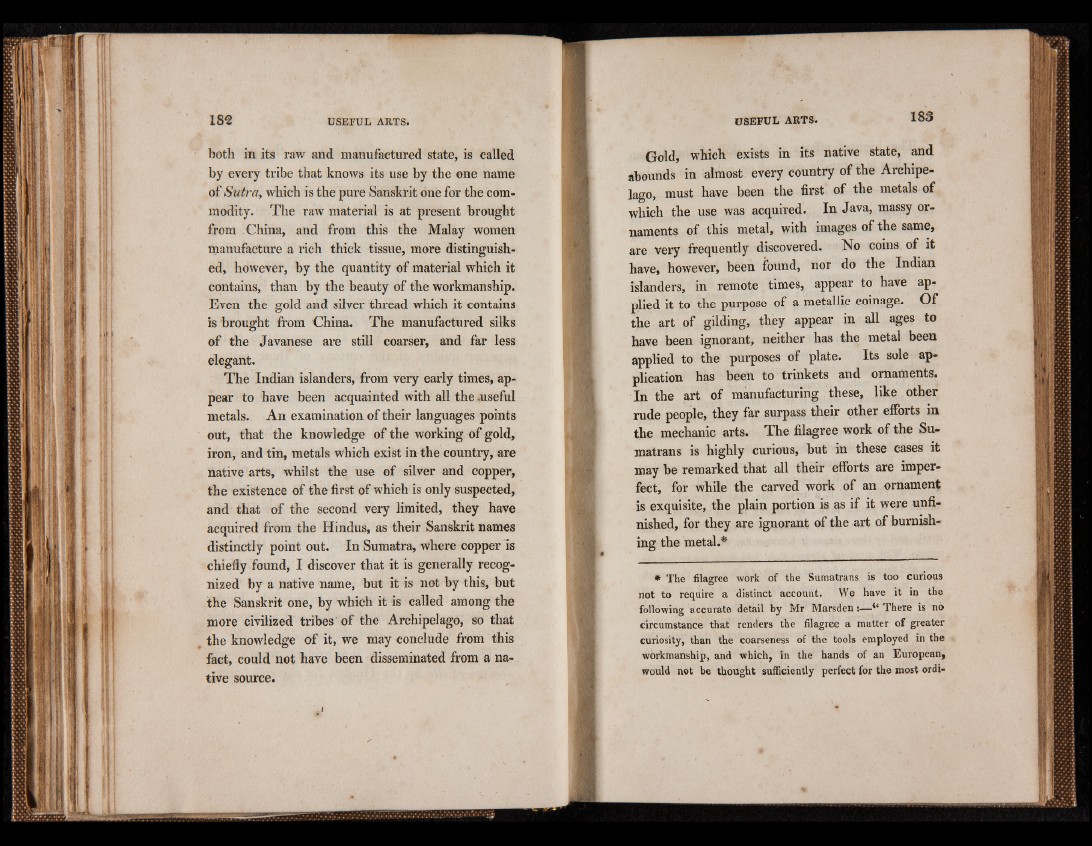
both in its raw and manufactured state, is called
by every tribe that knows its use by the one name
of Sutra, which is the pure Sanskrit one for the commodity.
The raw material is at present brought
from China, and from this the Malay women
manufacture a rich thick tissue, more distinguished,
however, by the quantity of material which it
contains, than by the beauty of the workmanship.
Even the gold and silver thread which it contains
is brought from China. The manufactured silks
of the Javanese are still coarser, and far less
elegant.
The Indian islanders, from very early times, appear
to have been acquainted with all the .useful
metals. An examination of their languages points
out, that the knowledge of the working of gold,
iron, and tin, metals which exist in the country, are
native arts, whilst the use of silver and copper,
the existence of the first of which is only suspected,
and that of the second very limited, they have
acquired from the Hindus, as their Sanskrit names
distinctly point out. In Sumatra, where copper is
chiefly found, I discover that it is generally recognized
by a native name, but it is not by this, but
the Sanskrit one, by which it is called among the
more civilized tribes' of the Archipelago, so that
’ the knowledge of it, we may conclude from this
fact, could not have been disseminated from a native
source.
Gold, which exists in its native state, and
abounds in almost every country of the Archipelago,
must have been the first of the metals of
which the use was acquired. In Java, massy ornaments
of this metal, with images of the same,
are very frequently discovered. No coins of it
have, however, been found, nor do the Indian
islanders, in remote times, appear to have applied
it to the purpose of a metallic coinage. Of
the art of gilding, they appear in all ages to
have been ignorant, neither has the metal been
applied to the purposes of plate. Its sole application
has been to trinkets and ornaments.
In the art of manufacturing these, like other
rude people, they far surpass their other efforts in
the mechanic arts. The filagree work of the Sumatrans
is highly curious, but in these cases it
may be remarked that all their efforts are imperfect,
for while the carved work of an ornament
is exquisite, the plain portion is as if it were unfinished,
for they are ignorant of the art of burnishing
the metal.*
* The filagree work of the Sumatrans is too curious
not to require a distinct account. We have it in the
following accurate detail by Mr Marsden There is no
circumstance that renders the filagree a matter of greater
curiosity, than the coarseness of the tools employed in the
workmanship, and which, in the hands of an European,
would not be thought sufficiently perfect for the most ordi